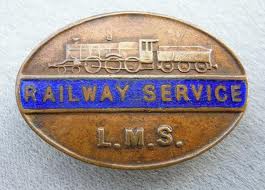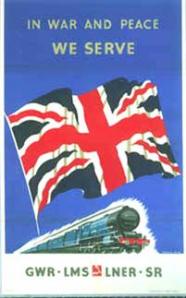Railways at War 'WW2'
During WW2, railway employees were considered to be important enough to ensure that the transport would keep running that they were placed into the "Reserved Occupation" category which meant that they would not get called up for Military service. To identify this fact, they were each issued with a brass & enamel oval lapel badge similar to the one shown here. Each of the badges of the four Railway Companies were similar in shape, but each Company had their own initials underneath the blue enamel strip (LMS in this case) and a different locomotive above. Each badge had a serial number stamped on the back which was registered at headquarters so that the owner could be identified.

During the war the
railways were heavily relied on to carry materials to build new war
factories, the materials to make munitions, troops and all their heavy
equipment ranging from the heaviest naval guns and tanks to the lightest
rifles and pieces of equipment rolled along the railways. Aircraft,
petrol and fuels; ammunition, bombs, mines, shells and foodstuffs, the
list is endless.
Vast tonnages of high explosives were carried on the
railways’ freight services, thousands on thousands of tons of dangerous
goods were safely conveyed.
Several thousand additional trains were run every week to convey workers to and from Government and privately owned factories. During 1942, 400 million passenger journeys were made by the holders of Workmen’s Tickets.
Amongst the heaviest freight trains were “block” coal trains worked by the L.M.S. from Midland collieries to the South.
Locomotives
of the British railways attained huge mileages, 100,000 miles being
frequently run between general repairs. On the G.W.R. freight engines
recorded 1,500 miles between Mondays and Fridays, and L.M.S. diesel
locomotives work 144 hours continually every week. Express passenger
locomotives which before the war worked exclusively on passenger trains
were being used for the haulage of war goods trains. The stock of
locomotives became more of a standard design and engines were being used
over much wider areas, resulting in a much smaller variety of spare
parts, less time required for fitting them, and less manufacture.
Strenuous efforts were made to speed up repairs to railway locomotives
and to keep as many in traffic as long as possible without overhaul.

Spread throughout Britain there
were twice as many railway women as railway men. They were without
102,984 of their colleagues released to join H.M. Forces; 90,000 trained
as Home Guards and 170,000 fully trained in Civil Defence. The Railways
were among the first to form their own L.D.V. (Home Guard) units;
hundreds of thousands of railway men volunteered.
Amongst the units
of the Army almost exclusively manned by trained personnel drawn from
the railways were the Dock Groups, Movement Control units, and Railway
Construction Companies of the Royal Engineers.
Before the war the
railways employed 26,000 women, mainly in the clerical grades, as
shorthand typists, machine telegraph and telephone operators, and in
smaller numbers as carriage cleaners, waiting-room attendants, cooks and
mess-room attendants, crossing keepers and office cleaners.
Since
the outbreak of the war women were trained and employed in many other
trades as men were released to the Forces. Their employment was under a
national scheme, and, by agreement with the trade unions, women employed
on manual work formerly done by a man were, after an agreed period,
paid the standard rate of the man replaced.
At passenger and goods
stations women handled parcels and merchandise. They checked and weighed
goods and acted as porters, signalmen and lamp men and “man” the horses
and delivery vans and acted as stablemen. Women also did the work of
booking and enquiry clerks and announce, by loud speaker, the arrival
and departure of trains and other notices to passengers. Women also
acted as ticket collectors and cleaners on the London tubes.
In the
engine sheds and docks the work is usually heavy. Women were employed as
loaders and porters and on engines as oilers, greasers and
firelighters. They helped in the maintenance of the permanent way, and
in the workshops they did useful work in most trades and were able to
undertake skilled work as core-makers, coppersmiths, concrete mixers,
turners, welders, etc.
The
British railway woman adapted herself quickly to new surroundings and
work which was very different from her pre-war occupation and she took
her share of night work. Often her husband was in the Forces, and she
showed a marked devotion to duty, sometimes in difficult circumstances
during and after enemy air activity. She did her turn of duty and went
home to the cares of a house and children. She made a vitally important
contribution to the war effort.
The
zoning of supplies, district by district, to make each area of the
country as self-supporting as possible, meant the re-arrangement of
hundreds of freight services. The increase of home-grown foodstuffs,
with millions of acres of land under cultivation, resulted in increasing
demands for railway transport. Fertilisers, seed potatoes, sugar beet,
tractors and farming equipment, as well as land workers, were catered
for, frequently by special trains.
Meanwhile, owing to the shortage
of cups and glasses for refreshments at stations, amounting to 5,000,000
cups, passengers were advised to carry their own drinking utensils!!!
Other
changes to the railways was to take away the status of 'going to the
seaside by train' and all posters were taken down. Place names were
painted out on stations so if they enemy did invade it would lessen the
chance of them knowing where they were. Stations and signal boxes were
made blast proof by putting tape on the windows and air raid shelters
were provided but not for staff, they were to stay in their positions as
the trains still ran during air raids but at a maximum of 30 mph. If a
stretch of track or building was damaged or destroyed by bombing, work
would start immediately to repair or replace the damage as the railways
were in fully operational 24 hours a day, seven days a week.

